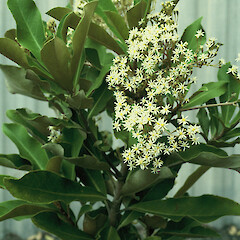Olearia crebra
Synonyms
None
Family
Asteraceae
Flora category
Vascular – Native
Endemic taxon
Yes
Endemic genus
No
Endemic family
No
Structural class
Trees & Shrubs - Dicotyledons
Chromosome number
2n = 108
Current conservation status
The conservation status of all known New Zealand vascular plant taxa at the rank of species and below were reassessed in 2017 using the New Zealand Threat Classification System (NZTCS) – more information about this can be found on the NZTCS website. This report includes a statistical summary and brief notes on changes since 2012 and replaces all previous NZTCS lists for vascular plants.
Please note, threat classifications are often suggested by authors when publications fall between NZTCS assessment periods – an interim threat classification status has not been assessed by the NZTCS panel.
- Conservation status of New Zealand indigenous vascular plants, 2017 . 2018. Peter J. de Lange, Jeremy R. Rolfe, John W. Barkla, Shannel P. Courtney, Paul D. Champion, Leon R. Perrie, Sarah M. Beadel, Kerry A. Ford, Ilse Breitwieser, Ines Schönberger, Rowan Hindmarsh-Walls, Peter B. Heenan and Kate Ladley. Department of Conservation. Source: NZTCS and licensed by DOC for reuse under the Creative Commons Attribution 4.0 International licence.
2017 | Threatened – Nationally Endangered | Qualifiers: RR
Previous conservation statuses
2012 | Threatened – Nationally Endangered | Qualifiers: RR
2009 | Threatened – Nationally Endangered | Qualifiers: CD, RR
2004 | Threatened – Nationally Endangered
Brief description
Small tree bearing very large leathery leaves that have a rusty brown fuzzy underside inhabiting upland Waima Forest in Northland. Leaves 80-290 mm long. Flowers white with yellow centre, body 10-12 mm long. Seeds small, with a hairy tip.
Distribution
Endemic. North Island, Waima Forest, where it is known from the local high points of Hauturu, Te Raupua and Mt Misery.
Habitat
In cloud forest. Now primarily on cliff faces, although this habitat is probably not entirely natural - the cliffs are acting as refugia from goats and other browsing animals, which periodically plague the only known habitats of this species.
Detailed description
Small tree 4-7 m tall, with upright to spreading growth form. Bark light grey, somewhat rough and peeling off in small plates. Petiole 10-20 x 2-2.45 mm. Leaves clustered in groups of 8-12 at branch apices, alternate, 80-290 x 45-120 mm, elliptic, obovate to oblanceolate, coriaceous, upper surface dark green, under sides covered in red brown appressed tomentum; lamina margin somewhat sinuate, apex obtuse; base cuneate to attenuate. Inflorescence a lateral panicle of 210-220 capitula. Capitulum 10-12 mm long. Pedicel 7-15 mm long, densely invested in short fulvous hairs. Involucre cylindrical, bracts (30-)40-54, spiraled in 7-9 rows, light brown, recurved at maturity; outer bracts 1.5-2.6 x 0.8-1.4 mm, narrowly triangular, outer surface sparsely to moderately hairy, margins fimbriate. Florets 18-26 per capitulum. Ray-florets 10-15, pistillate; corolla glabrous, tube 2.7 mm long, ligulate with deflexed white limb 3.5-8 x 1.2-1.6 mm, 2-3-lobed at apex. Disc florets 8-11, hermaphrodite, corolla glabrous, white, tube 3.3. mm long, lobes 5, 1.5 x 0.6 mm. Seeds (cypselae) 1.7-3 x 0.4-0.5 mm, narrow-cylindric, brown, 5-6-ribbed, glabrous to sparsely hairy; pappus 3.5-4.5 mm, cream, finely scabrid.
Similar taxa
None. Well marked by the small tree habit, very large leaves with red-brown undersides, and the large number of involucral bracts. This last character it shares with O. pachyphylla Cheeseman, which is otherwise a much smaller shrub, with smaller leaves and capitula which have 1-3 ray florets.
Flowering
November to January
Flower colours
White, Yellow
Fruiting
January to April
Propagation technique
Difficult except in damp cool climates. Can be grown from semi-hardwood cuttings and fresh seed. Very susceptible to phytophora and verticillium wilt, and so prone to sudden collapse in gardens located within warm or humid climates.
Threats
Severely threatened by animal browse, especially as this species is known from only four very small populations located within vulnerable ridges crests frequented by feral goats, cattle, horses and possums. Despite ongoing wild animal control, this species remains very vulnerable to even small numbers of these animals.
Etymology
olearia: Named after Johann Gottfried Olearius, a 17th-century German scholar, writer of hymns and author of Specimen Florae Hallensis
Where To Buy
Not commericially available.
Attribution
Fact Sheet prepared for the NZPCN by P.J. de Lange 14 April (2006). Description by P.B Heenan (adapted from Heenan & Cameron 2002) and subsequently published in de Lange et al. (2010).
References and further reading
de Lange, P.J.; Heenan, P.B.; Norton, D.A.; Rolfe, J.R. & Sawyer, J.W.D. 2010: Threatened Plants of New Zealand. Canterbury University Press, Christchurch.
Heenan, P.B. & Cameron, E.K. 2002: A new species of Olearia from Waima Forest, Northland, New Zealand. New Zealand Journal of Botany 40(4): 535-542.
NZPCN Fact Sheet citation
Please cite as: de Lange, P.J. (Year at time of access): Olearia crebra Fact Sheet (content continuously updated). New Zealand Plant Conservation Network. https://www.nzpcn.org.nz/flora/species/olearia-crebra/ (Date website was queried)













